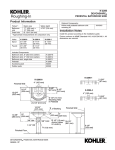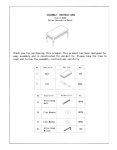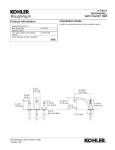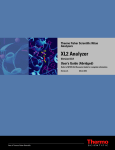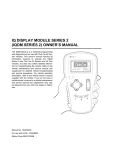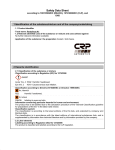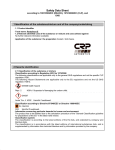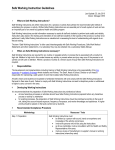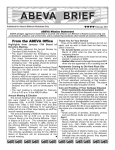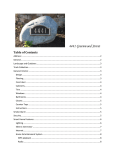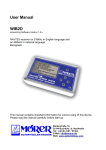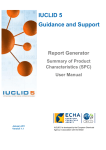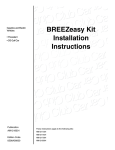Download Use of the handheld XRF
Transcript
HERO Health and Safety Specific local rules for governing the use of the Niton XLt Environmental Analyser (portable XRF): Laboratory 1. These Local Rules are supplementary to the University Rules for Radiation Use. All users are required to refer to and follow these rules. 2. Users of this instrument are registered as designated radiation workers with the university and approved as an authorised user by the Radiation Protection Supervisor (RPS), Dr Neil Gray (x4887), or deputy following training. 3. The XRF is locked in the cupboard in laboratory 3.7C 3rd Floor Devonshire Building whilst not in use. Authorised users can only obtain the cupboard key and operating password from Jane Davis or Patrick Orme. 4. Authorised users are required at the start of every operational period to check for possible x-ray leakage using the series 900 X mini-monitor. Any counts on the using this monitor above the following values must be reported to the RPS: a. Tube area (not in use)* = 5 cps 1 b. Tube area (in use)* = 200 cps c. Finger trigger* = 5 cps 5. While the XRF is in use (shutters open) and the external warning lights are flashing, a radiation sign is hung on the entry door to room 3.7C, 3rd floor Devonshire Building. 6. The XRF is used with the sample holder and remotely operated using the PC when possible. If the XRF is not to be used in the holder then the area is designated as “controlled” and the unit is held at arms length and not directed towards any person or the door. Persons must not stand within a 2 metre radius of the tube head. 7. All users of the XRF must read the radiation risk assessment, the Local Rules and sign the declaration before being authorised to use the equipment. 8. Any adjustment operations or machine failures which require enclosures to be removed must not be attempted. These should be reported and carried out by authorised persons at Niton: John Hurley T: 01256 397860 or 07979595418 8. For operational instructions contact Jane Davis or Patrick Orme and refer to the user’s manual. List of authorised users for the XRF: Authorised user Jane Davis Patrick Orme 1 5 cps (counts per second) ≈ 1 µSv/h ≈ 1µGy/h * Assumed use WITH steel encased holder Ver 2 180907 Telephone number 4941 4942 HERO Health and Safety Specific local rules for governing the use of the Niton XLt Environmental Analyser (portable XRF): Field use 1. These Local Rules are supplementary to the University Rules for Radiation Use. All users are required to refer to and follow these rules. 2. Users of this instrument are registered as designated radiation workers with the university and approved as an authorised user by the Radiation Protection Supervisor (RPS), Dr Neil Gray (x4887), or deputy following training. 3. The XRF is locked in the cupboard in laboratory 3.7C, 3rd Floor Devonshire Building whilst not in use. Authorised users can only obtain the cupboard key and operating password from Jane Davis or Patrick Orme. 4. Authorised users are required at the start of every operational period to check for possible x-ray leakage using the mini-monitor 900 X. Any counts above the following values must be reported to the RPS: a. Tube area (not in use)* = 5 cps1 b. Tube area (in use)* = 300 cps2 c. Finger trigger* = 10 cps 5. All users of the XRF must read the radiation risk assessment, the Local Rules and sign the declaration before being authorised to use the equipment. 6. Before leaving the university, details of the site visit must be recorded in the log book. This entry must be completed immediately on safe return of the machine. 7. While the XRF is in use (shutters open) and the external warning lights are flashing, time spent immediately adjacent to the machine must be kept at a minimum. Users should make exposures using the PC whenever possible. 8. During use the area within a 2 metre radius of the head is designated as “controlled”. Operation is undertaken at arms length and must not be directed towards any persons. The radiation sign must be clearly displayed during use. 9. In the event of an accident immediate medical attention must be sought and the Radiation Protection Supervisor, Dr. Neil Gray, should be informed (0191 246 4887). 10. The XRF should not be left unattended and in view in the vehicle. If the vehicle has to be left unattended it must be securely locked in the boot. 11. Any adjustment operations or machine failures which require enclosures to be removed must not be attempted. These should be reported and carried out by authorised persons at Niton: John Hurley T: 01256 397860 or 07979595418 For operational instructions contact Jane Davis or Patrick Orme and refer to the user’s manual. 1 5 cps (counts per second) ≈ 1 µSv/h ≈ 1µGy/h * Assumed use WITHOUT steel encased holder 2 Assumed emitter window is flush against the sample Ver 2 180907 HERO Health and Safety Safety information for governing the use of the Niton XLt Environmental Analyser (portable XRF) Check for any x-ray leaks using the mini-monitor – kept in room 3.7C 3rd Floor Devonshire Building. Radiation values detected from checks carried out by the University Radiation Protection Officer, Simon Willis, are shown in table 1 below. Should levels exceed the maximum dose rate allowed (accepted upper limits provided by Niton, listed in the user manual), the Radiation Protection Supervisor, Dr. Neil Gray, should be contacted for any advice (x4887) Table 1. Area checked for Leakage Dose Rate or detected radiation Used WITHOUT Used WITH steel encasing steel encasing Maximum dose rate allowed XRF not in use <0.1 cps 1 <1 µSv/hr <0.1 cps <1 µSv/hr n/a Finger trigger <0.1 cps <1 µSv/hr 0.5 cps 0.1 µSv/hr 0.9 µSv/hr Direct Exposure 100 cps @ 0 cm (20 µS/hr @ 0 cm) ~150 cps @ 0 cm 2 20 cps @ 5cm (~30 µS/hr @ 0 cm) 19.3 mSv/hr @ 5 cm 0.028 mSv/hr @ 100 cm (5 µS/hr @ 5 cm) Measurements in cps used a Mini 900 X For reference, annual occupational dose limits for adults and typical dose limits for selected medical requirements are outlined in table 2 below: Table 2. Subject Dose Rate or detected radiation Annual occupational dose limits for adults Whole body 20 mSv Pregnant worker 1 mSv Selected medical requirements Typical chest x-ray 0.06 mSv Typical head / neck x-ray 0.2 mSv Typical pelvis / hip x-ray 0.65 mSv Typical CAT scan 1.1 mSv Internationally recognised limits set by the International Commission for Radiological Protection (ICRP) www.icrp.org 1 2 5 cps (counts per second) ≈ 1 µSv/h ≈ 1µGy/h Assumed emitter window is flush against the sample Version 2 180907 RISK ASSESSMENT FORM University of Newcastle HERO Group ASSESSMENT OF RISK ASSOCIATED WITH PROPOSED EXPERIMENTS OR PROJECT __________________________________________________________________________________ Personnel involved: …………………………………………………………………………………….. (inc. status) __________________________________________________________________________________ Title of Experiment/Procedure: ………………………………………………………………...……….. Aim: ……………………………………………………………………………………………………. …………………………………………………………………………………………………………… __________________________________________________________________________________ Substances used: …X-ray beams….... Or activity ……………………….. Hazards identified: …Radiation…………….. .……………………………. ……………………….. …………………………….. ……………………….. …………………………….. __________________________________________________________________________________ Sources of information on which this is based: ………………………………………………………... ……Instrument manual…………..……………………………………………………………… …………………………………………………………………………………………………..……….. __________________________________________________________________________________ Do quantities/dilutions of the substances identified make normal "Good Chemical Practice" sufficient? Y/N If "yes", no further assessment is necessary - please sign over the page. __________________________________________________________________________________ Is there a less hazardous alternative? Y/N If "yes", why not use it? ………………………………………………………………………………... …………………………………………………………………………………………………………… __________________________________________________________________________________ Control measures to be adopted: (N.B. Consider cleaners, contractors, maintenance staff as well as research staff: use a continuation sheet if necessary). Enter Containment level (i.e. operating fume cupboard, etc.) ……Use protective steel casing.………………………………………………………………… ……Place radiation sign on door of room….………………………………………………… __________________________________________________________________________________ Required checks and their frequency, on the adequacy and maintenance of control measures in the course of the experiment: (N.B. State if any health surveillance is necessary) ……Use Geiger counter if necessary (see specific local rules: laboratory)………… __________________________________________________________________________________ Disposal procedures during and at end of experiment: ……N/A………………………………………………………………………. 1 Estimated cost of disposal £……… __________________________________________________________________________________ EMERGENCY PROCEDURES If any of the substances or procedures identified above are likely to pose a special hazard in any emergency, then identify below the action to be taken: __________________________________________________________________________________ Spillage/uncontrolled release: ………………………………………………………………………….. ……Inform the Radiation Protection officer – Dr. Neil Gray 0191 246 4887 – and seek immediate medical attention..……………………………………………………… …………………………………………………………………………………………………………… __________________________________________________________________________________ Fire ……N/A………………………………………………………………………………………………... …………………………………………………………………………………………………………… __________________________________________________________________________________ If personnel are affected (fumes, contamination etc.) treatment to be adopted: (N.B. Antidotes and special treatments may be obtained through the University Health Service.) Inform the Radiation Protection officer – Dr. Neil Gray 0191 246 4887 – and seek immediate medical attention …..…………………………………………………… …… …………………………………………………………………………………………………………… __________________________________________________________________________________ Additional Information (where appropriate) e.g.quantities and frequencies: ……Use only in protective steel casing…………….………………………………………… ……Place radiation sign on door of room.…………………………………………………… …………………………………………………………………………………………………………… …………………………………………………………………………………………………………… …………………………………………………………………………………………………………… …………………………………………………………………………………………………………… …………………………………………………………………………………………………………… …………………………………………………………………………………………………………… Name of Assessor: _________________________ Status of Assessor _________________________ Date _________ Signed _______________ Name of Supervisor: (for students only) _________________________ Date _________ Signed _______________ Head of School _________________________ Date _________ Signed ______________ 2 DECLARATION OF SAFETY INDUCTION PROCEDURE University of Newcastle HERO Group Part 1 - (Labworker’s copy) New arrivals in the laboratory must be introduced to the safety policy by either: (i) a lecture or (ii) a one-to-one session with a technician or member of academic staff. (labworker name) ........................................................ has had the safety policy explained to them. Signature of Inductor ....................................... (member of staff) I have understood the hazards and rules of the HERO Group Laboratory. Signed (labworker signature) ................................................................ Date .................................................................. Retain this form for your records 3 Declaration of Safety Induction Procedure Part 2 - (University Copy) New arrivals in the laboratory must be introduced to the safety policy by either: (i) a lecture or (ii) a one-to-one session with a technician or member of academic staff. (labworker name) ........................................................ has had the safety policy explained to them. Signature of Inductor ....................................... (member of staff) I have understood the hazards and rules of the HERO Group Laboratory. Signed (labworker signature) ................................................................ Date .................................................................. Undergraduates and Masters students should produce the completed form at their first laboratory class (research students on first day of lab work) and hand it to the member of staff (Inductor) or Laboratory Technician. 4







